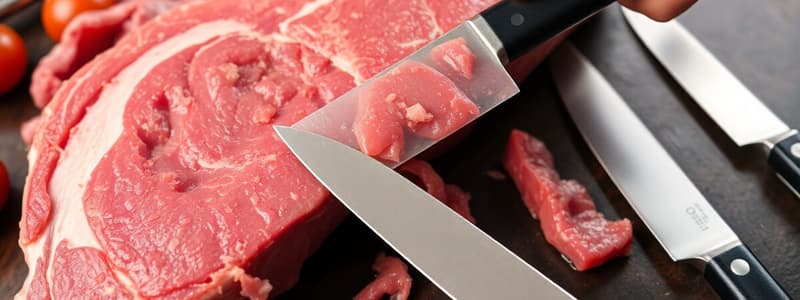Podcast
Questions and Answers
What does SRMs stand for in the context of livestock handling?
What does SRMs stand for in the context of livestock handling?
- Standard Risk Materials
- Special Regulations for Materials
- Specified Risk Materials (correct)
- Sanitation Risk Materials
Which of the following is NOT a type of fat deposit found in cattle?
Which of the following is NOT a type of fat deposit found in cattle?
- Subdermal fat (correct)
- Subcutaneous fat
- Intramuscular fat
- Intermuscular fat
What is the primary purpose of Sanitation Standard Operating Procedures (SSOP)?
What is the primary purpose of Sanitation Standard Operating Procedures (SSOP)?
- To monitor livestock feed quality
- To regulate livestock reproductive practices
- To ensure hygiene in food processing (correct)
- To conduct postmortem inspections
Which vertebrae are included in the cervical section of a cattle's skeleton?
Which vertebrae are included in the cervical section of a cattle's skeleton?
What is the purpose of honing a knife?
What is the purpose of honing a knife?
What connects individual muscle fibers within muscles?
What connects individual muscle fibers within muscles?
Which of the following is NOT one of the 7 principles of HACCP?
Which of the following is NOT one of the 7 principles of HACCP?
What is the primary focus of antemortem inspection?
What is the primary focus of antemortem inspection?
Which bones are included in the pelvic girdle of livestock?
Which bones are included in the pelvic girdle of livestock?
What is the term used to describe the process of bone aging?
What is the term used to describe the process of bone aging?
What color is the stamp that indicates meat is 'U.S. Inspected and Passed'?
What color is the stamp that indicates meat is 'U.S. Inspected and Passed'?
Which act requires microbial testing and HACCP system implementation?
Which act requires microbial testing and HACCP system implementation?
What is the function of the heavy yellow connective tissue found in the neck and rib area of a beef carcass?
What is the function of the heavy yellow connective tissue found in the neck and rib area of a beef carcass?
What is the main purpose of SSOP in meat plants?
What is the main purpose of SSOP in meat plants?
Which of the following is a characteristic of a knife steel?
Which of the following is a characteristic of a knife steel?
Which of the following is NOT one of the 5 principles of meat cutting?
Which of the following is NOT one of the 5 principles of meat cutting?
What do the Institutional Meat Purchase Specifications (IMPS) represent?
What do the Institutional Meat Purchase Specifications (IMPS) represent?
What kind of animals would likely be designated as 'U.S. Condemned'?
What kind of animals would likely be designated as 'U.S. Condemned'?
Which of the following cuts is considered a 'fat' cut and a major wholesale cut?
Which of the following cuts is considered a 'fat' cut and a major wholesale cut?
Which retail standard provides consistent labeling for fresh meat cuts?
Which retail standard provides consistent labeling for fresh meat cuts?
Which species has the IMPS series number of 400?
Which species has the IMPS series number of 400?
What type of bone is found in the Porterhouse/T-bone steak?
What type of bone is found in the Porterhouse/T-bone steak?
Which muscle is located in the Beef Chuck 7-Bone Steak?
Which muscle is located in the Beef Chuck 7-Bone Steak?
What is the main reason for withholding feed 12-24 hours before slaughter?
What is the main reason for withholding feed 12-24 hours before slaughter?
What does DFD stand for in the context of meat quality?
What does DFD stand for in the context of meat quality?
Which muscle is prominently found in the Beef Loin-Porterhouse Steak?
Which muscle is prominently found in the Beef Loin-Porterhouse Steak?
What season is characterized as the Soft-hair season?
What season is characterized as the Soft-hair season?
What does PSE stand for in meat quality terminology?
What does PSE stand for in meat quality terminology?
Which piece of equipment is used during the pork slaughter process?
Which piece of equipment is used during the pork slaughter process?
What is the primary purpose of bunging during pork processing?
What is the primary purpose of bunging during pork processing?
Which of the following best describes the term 'viscera'?
Which of the following best describes the term 'viscera'?
What anatomy is referred to as 'pluck' in the context of pork slaughter?
What anatomy is referred to as 'pluck' in the context of pork slaughter?
What is the dressing percentage for pigs typically considered as?
What is the dressing percentage for pigs typically considered as?
How is the dressing percentage calculated?
How is the dressing percentage calculated?
What grade is assigned to a carcass that is PSE?
What grade is assigned to a carcass that is PSE?
Which muscling score corresponds to thin muscling in pork carcasses?
Which muscling score corresponds to thin muscling in pork carcasses?
What is the minimum belly thickness for grading in pork?
What is the minimum belly thickness for grading in pork?
Flashcards are hidden until you start studying
Study Notes
Lab 1 - Orientation and Meat Inspection
- Essential knife types: Skinning Knife, Boning Knife, Steel, Scabbard.
- Knife Sharpening Procedures:
- Grinding: Full replacement of knife edge, usually for new/abused knives.
- Honing: Replacing edge post normal use.
- Steeling: Regular edge maintenance at a 20-25 degree angle.
- HACCP: Stands for Hazard Analysis Critical Control Points; consists of 7 principles:
- Conduct hazard analysis
- Determine CCP (Critical Control Points)
- Establish critical limits
- Establish monitoring procedures
- Establish corrective actions
- Establish verification procedures
- Establish record-keeping/documentation procedures
- Antemortem Inspection: Conducted prior to slaughter; identifies animals that are dead or disease-symptomatic.
- Postmortem Inspection: Conducted after slaughter; inspects carcass condition.
- Major meat inspection laws:
- Meat Inspection Act of 1906: Federal inspection requirement in commerce, inspired by The Jungle.
- Wholesome Meat Act (1967): Established "equal to" standards.
- Pathogen Reduction and HACCP Systems (1996): Required testing and HACCP compliance after E.coli outbreak.
- SSOP: Sanitation Standard Operating Procedures; examples necessary for meat facility cleanliness.
- SRMs: Specified Risk Materials; in cattle, refers to BSE risk areas including tonsils and distal ileum.
- Inspection stamp color for "U.S. Inspected and Passed": Purple.
Lab 2 - Anatomy
- Four fat deposit types:
- Perinephric: Internal fat (e.g., KPH)
- Intermuscular: Seam fat
- Subcutaneous: External fat
- Intramuscular: Marbling
- Axial Skeleton: Comprises head, vertebral column, ribs, sternum.
- Appendicular Skeleton: Includes thoracic and pelvic limbs; the visceral skeleton is the Splanchnic Skeleton.
- Cattle vertebrae count:
- Cervical: 7
- Thoracic: 13
- Lumbar: 6
- Sacral: 5
- Coccygeal: 18-20
- First cervical vertebrae names: Atlas and Axis.
- Head removal occurs between occipital condyles and atlas vertebrae.
- Ribs articulating with the sternum identified as Sternum Ribs.
- Endochondral Ossification: Describes the aging process of bones.
- Connective tissue layers in muscles:
- Epimysium: Surrounds entire muscle
- Perimysium: Surrounds muscle bundles
- Endomysium: Surrounds individual fibers.
- Study diagrams of meat cuts and corresponding muscles.
Lab 3 - Pork Slaughter
- Stunning method: Electrical for pork slaughter.
- Key definitions:
- DFD: Dark, Firm, Dry
- PSE: Pale, Soft, Exudative
- PSS: Porcine Stress Syndrome
- Feed is withheld 12-24 hours pre-slaughter to ease evisceration and minimize bacterial migration.
- Free access to water prior to slaughter enhances bleeding, color, and electrical stunning efficiency.
- Humane Slaughter Act mandates stunning before bleeding.
- Seasonal distinctions: Soft-hair season in Feb-April, Hard-hair season in Sept-Nov.
- Key processes:
- Bunging: Prevents contamination and maintains sanitation.
- Evisceration: Removal of internal organs.
- Carcass calculations: Dressing percentage formula: DP% = (Carcass Weight / Live Weight) x 100; typical dressing percentage for pigs is about 70%.
- Pork evaluation focuses on quality grading based on color, firmness, and marbling scores.
- Two quality grades for pork: US and US Utility.
- Minimal belly thickness for grading: 0.6 inches.
- IMPS: Institutional Meat Purchase Specifications; guides meat purchase.
- NAMP: North American Meat Processors Association; sets standards for meat cuts.
- URMIS: Uniform Retail Meat Identity Standards; standard labeling for fresh meat cuts.
Pork Fabrication
- Five principles of meat cutting:
- Separate fat from lean.
- Separate tough from tender cuts.
- Separate thin from thick sections.
- Separate valuable from less valuable cuts.
- Cut across the grain for retail cuts.
- Lean cuts include: Ham, Loin, Boston Butt, Picnic Shoulder.
- Major wholesale "bony" cuts: Spareribs.
- Major wholesale "fat" cut: Belly.
- IMPS series for pork: 400.
Studying That Suits You
Use AI to generate personalized quizzes and flashcards to suit your learning preferences.




